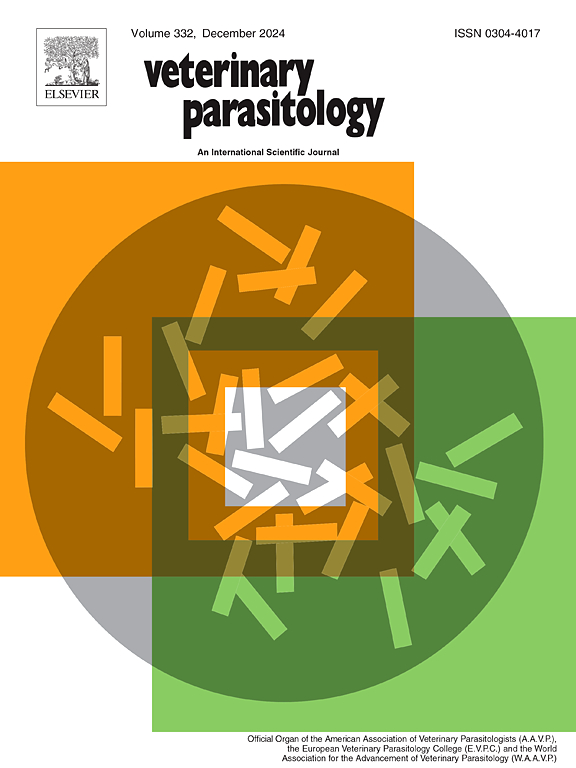不同植物提取物对肉苁蓉组织单胞菌体外和体内的抑制作用
IF 2
2区 农林科学
Q2 PARASITOLOGY
引用次数: 0
摘要
组织菌病是由肉鸡组织单胞菌引起的一种原生动物疾病,可导致家禽盲肠炎症和肝坏死。自2015年尼塔胂停药以来,目前缺乏经批准的组织吸胞菌病预防药物。为了寻找潜在的替代品,本研究评估了7种商业植物提取物对肉苁蓉体外生长的抑制作用。此外,对三种最有前途的植物提取物的体内有效性进行了评估。结果表明,7种植物提取物均具有抗组织作用。鱼腥草酸钠、大黄素和蛇床子素的最小致死浓度分别为0.25、0.5和1 mg/mL,在这些提取物中表现出最高的效果。随后,这三种植物提取物进行了额外的体内试验。结果表明,与挑战对照组相比,这三种提取物均可减轻感染鸡的肝脏和盲肠损伤评分,同时促进感染后体重的增加。添加0.5 g/kg(饲料)鱼腥草酸钠组效果最显著,与二甲硝唑组相比,体重增加无显著差异(P <; 0.05)。然而,这三种植物提取物并没有使感染鸡的体重完全恢复到与空白对照相当的水平。实验结果表明,鱼腥草素钠、大黄素、蛇床子素均具有防治组织肺病的作用,其中鱼腥草素钠效果最好。本文章由计算机程序翻译,如有差异,请以英文原文为准。
Inhibitory effects of different plant extracts on Histomonas meleagridis in vitro and in vivo in chickens
Histomonosis is a protozoan disease that is caused by Histomonas meleagridis, which can lead to cecal inflammation and liver necrosis in poultry. Since the discontinuation of nitarsone in 2015, there is currently a lack of approved prophylactics for managing histomonosis. In search of potential alternatives, the present investigation evaluated the inhibitory effects of seven commercial plant extracts on the in vitro growth of H. meleagridis. Additionally, the in vivo effectiveness of three of the most promising plant extracts was evaluated. The study demonstrated that all seven plant extracts exhibited antihistomonal properties in vitro. Sodium houttuyfonate, emodin, and osthole displayed the highest effectiveness among these extracts, as evidenced by their respective minimal lethal concentration of 0.25, 0.5, and 1 mg/mL. Subsequently, these three plant extracts were employed in additional in vivo testing. The results indicated that all three extracts could mitigate liver and cecum lesion scores in infected chickens while facilitating a degree of body weight gain following infection compared to the challenged control. The group administered with 0.5 g/kg (feed) sodium houttuyfonate exhibited the most pronounced effect, as evidenced by the absence of a significant difference in weight gain compared to the dimetridazole group (P < 0.05). However, the three plant extracts did not fully restore the body weight of infected chickens to levels comparable with the blank control. The experimental results indicate that sodium houttuyfonate, emodin, and osthole possess properties that contribute to the prevention and treatment of histomonosis, with sodium houttuyfonate demonstrating the most favorable results.
求助全文
通过发布文献求助,成功后即可免费获取论文全文。
去求助
来源期刊

Veterinary parasitology
农林科学-寄生虫学
CiteScore
5.30
自引率
7.70%
发文量
126
审稿时长
36 days
期刊介绍:
The journal Veterinary Parasitology has an open access mirror journal,Veterinary Parasitology: X, sharing the same aims and scope, editorial team, submission system and rigorous peer review.
This journal is concerned with those aspects of helminthology, protozoology and entomology which are of interest to animal health investigators, veterinary practitioners and others with a special interest in parasitology. Papers of the highest quality dealing with all aspects of disease prevention, pathology, treatment, epidemiology, and control of parasites in all domesticated animals, fall within the scope of the journal. Papers of geographically limited (local) interest which are not of interest to an international audience will not be accepted. Authors who submit papers based on local data will need to indicate why their paper is relevant to a broader readership.
Parasitological studies on laboratory animals fall within the scope of the journal only if they provide a reasonably close model of a disease of domestic animals. Additionally the journal will consider papers relating to wildlife species where they may act as disease reservoirs to domestic animals, or as a zoonotic reservoir. Case studies considered to be unique or of specific interest to the journal, will also be considered on occasions at the Editors'' discretion. Papers dealing exclusively with the taxonomy of parasites do not fall within the scope of the journal.
 求助内容:
求助内容: 应助结果提醒方式:
应助结果提醒方式:


